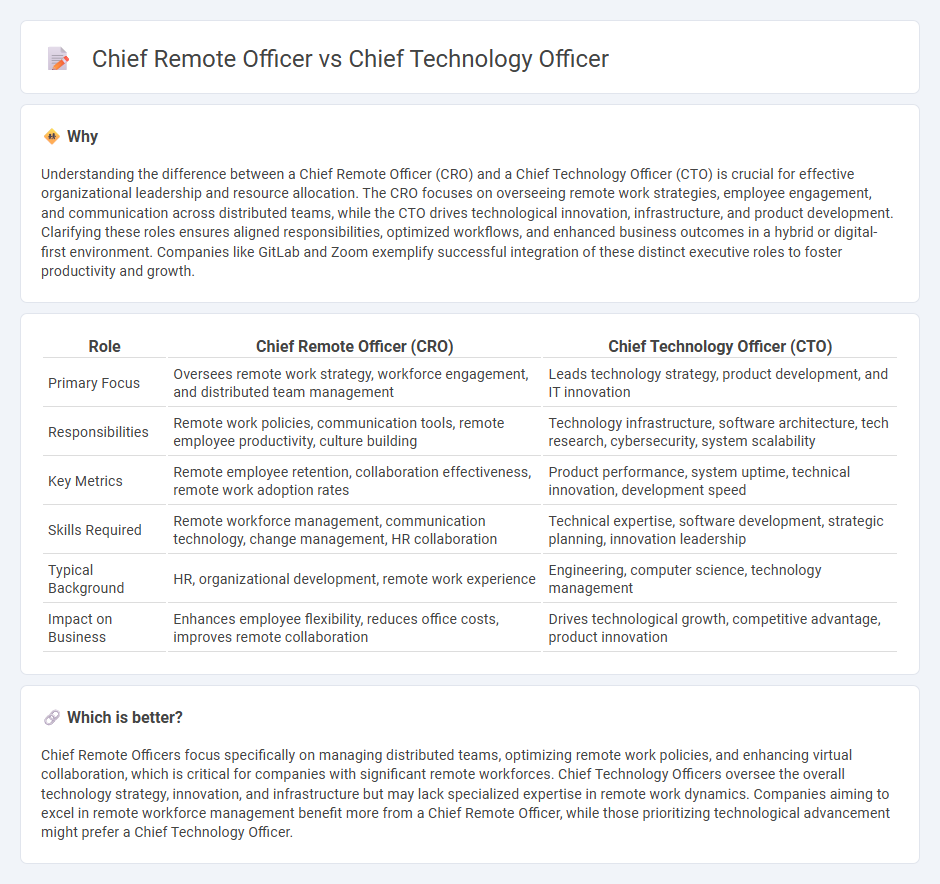
The Chief Remote Officer (CRO) specializes in overseeing distributed workforce strategies, enhancing remote employee engagement, and optimizing virtual collaboration tools. In contrast, the Chief Technology Officer (CTO) focuses on managing technological infrastructure, driving innovation, and aligning IT development with business goals. Explore the distinct roles and responsibilities that shape modern organizational leadership.
Why it is important
Understanding the difference between a Chief Remote Officer (CRO) and a Chief Technology Officer (CTO) is crucial for effective organizational leadership and resource allocation. The CRO focuses on overseeing remote work strategies, employee engagement, and communication across distributed teams, while the CTO drives technological innovation, infrastructure, and product development. Clarifying these roles ensures aligned responsibilities, optimized workflows, and enhanced business outcomes in a hybrid or digital-first environment. Companies like GitLab and Zoom exemplify successful integration of these distinct executive roles to foster productivity and growth.
Comparison Table
| Role | Chief Remote Officer (CRO) | Chief Technology Officer (CTO) |
|---|---|---|
| Primary Focus | Oversees remote work strategy, workforce engagement, and distributed team management | Leads technology strategy, product development, and IT innovation |
| Responsibilities | Remote work policies, communication tools, remote employee productivity, culture building | Technology infrastructure, software architecture, tech research, cybersecurity, system scalability |
| Key Metrics | Remote employee retention, collaboration effectiveness, remote work adoption rates | Product performance, system uptime, technical innovation, development speed |
| Skills Required | Remote workforce management, communication technology, change management, HR collaboration | Technical expertise, software development, strategic planning, innovation leadership |
| Typical Background | HR, organizational development, remote work experience | Engineering, computer science, technology management |
| Impact on Business | Enhances employee flexibility, reduces office costs, improves remote collaboration | Drives technological growth, competitive advantage, product innovation |
Which is better?
Chief Remote Officers focus specifically on managing distributed teams, optimizing remote work policies, and enhancing virtual collaboration, which is critical for companies with significant remote workforces. Chief Technology Officers oversee the overall technology strategy, innovation, and infrastructure but may lack specialized expertise in remote work dynamics. Companies aiming to excel in remote workforce management benefit more from a Chief Remote Officer, while those prioritizing technological advancement might prefer a Chief Technology Officer.
Connection
The Chief Remote Officer (CRO) and Chief Technology Officer (CTO) collaborate closely to design and implement technology solutions that support remote work infrastructure and enhance virtual team productivity. The CTO focuses on selecting and securing digital tools and platforms, while the CRO aligns these technologies with remote workforce management strategies and employee engagement. Their partnership ensures seamless communication, cybersecurity, and operational efficiency across distributed teams.
Key Terms
**Chief Technology Officer (CTO):**
Chief Technology Officer (CTO) leads innovation and technology strategy, overseeing software development, IT infrastructure, and product engineering to align with business goals. CTOs drive digital transformation, manage technology teams, and evaluate emerging technologies to maintain competitive advantage. Explore how CTOs shape the future of technology and business growth.
Innovation
A Chief Technology Officer (CTO) drives innovation by leading technology development, overseeing product engineering, and implementing cutting-edge solutions to enhance business growth. In contrast, a Chief Remote Officer (CRO) focuses on innovating remote work strategies, optimizing distributed team collaboration, and ensuring seamless digital communication infrastructure. Discover how these roles uniquely contribute to innovation by exploring their distinct responsibilities and impact on organizational transformation.
IT Strategy
The Chief Technology Officer (CTO) primarily oversees IT strategy, innovation, and technology infrastructure to drive business growth and maintain competitive advantage. The Chief Remote Officer (CRO), while less common, focuses on optimizing remote work policies, remote team collaboration, and digital workplace tools to support distributed workforces. Explore deeper insights into how these roles shape organizational success in the evolving digital landscape.
Source and External Links
What Is a CTO (Chief Technology Officer)? - A chief technology officer (CTO) determines an organization's technology strategy, overseeing the development and distribution of technology to external clients and vendors.
How to Become a Chief Technology Officer - A CTO is responsible for integrating business needs into IT planning and operations, focusing on creating technology for external customers.
Chief Technology Officer - Wikipedia - A CTO manages technical operations, overseeing research and development while serving as a technical advisor to higher executives like CEOs.
 dowidth.com
dowidth.com